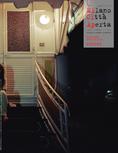urban theory special news cities urbanism premio letteratura urbanistica scenarios urbanization landscapes competition open position urban market regulation anthropology educational superplaces transport & logistics parks composition local development history city-regions ecology maps city urban regeneration
Issue #18 - WINTER/2014
from Milano Città Aperta
Milano Città Aperta | Journal of Urban Photography
A city is not designed, simply it creates itself.
It just needs to be listened because the city is the reflex of many stories.
Renzo Piano, "La responsabilità dell'architetto"
There are many ways of living a city. There are those who look for a safe shelter away from the traffic and the noise and choose a little house in the suburbs, those who can't afford a choice and end up in a microscopic hovel, there are the metropolitans who want to live in the more chaotic centre and there are the billionaires, owners of big private parks in corso Venezia. There are choices and there are necessities. The city is the more true mirror of the contradictions of our time.
People used to think that the role of the architect, or of the engineer, was that of a intermediary between markets's excesses and the construction of a city where everybody could find their ideal place to live. Then books have been written, films have been made, that showed us the "hands over the city". Maybe that naivety isn't possible anymore.
Maybe.
Today we live a disconnected city, made of thousands of small realities that hardly notice each other.
Necessities grow fast as fast diminishes the possibility for most people to have choices. Who can today actually afford to create his ideal living? Very few. Partner in crime, a macabre cunning of who still thinks that the city needs to be drawn from up.
Maybe there's a road that we can still take that leads us to imagine a different city, where every single life can redesign a plan not too far from utopia. A road that keeps far away fascisms of any kind and that preach the homogenization of the urban landscape. Maybe we can still make living a plurality of choices that converse with each other other than a single imposed necessity.
And here we are.
From the stories of nomad carnies to the houses of the insalubrious neighborhood of Santa Giulia, we came across the sight of the Rom community that lived the surroundings of via Malaga. We went to listen the stories of the elderlies in nursing homes and tried to better understand the initiative "Abitare a Milano", born from the collaboration between Politecnico and the municipality, that could lead to a return to a serious reflection on the idea of popular and public building.
INDEX
• Santa Giulia ora pro nobis
by Luca Rotondo
The district Santa Giulia in Milan, is located on an polluted aquifer dangerous to health. As in a harrowing convalescence, all people expect someone that intervenes to repair.
• Last Home
by Luca Napoli
Many small life stories from a nursing home. Where there is still time for a smile.
• Abitare Milano
by Thomas Pagani
Housing dimensions suspended between the operation of urban planning and re-planning the " new parts of the city " that could become.
• Ex Campo Rom di Via Malaga
by Guido Maria Isolabella
On 10 September 2013, was cleared of the Rom camp via Malaga. The former occupants have not challenged the decision of the City hall because they were afraid.
• Luna Park
by Giorgia Valli
Discovering the carnies. An ancient craft that marvels and enchants.
• Spazi di confine
by Viviana Falcomer
The corridors of the large residential buildings as situational moments, "border areas" in which the strangeness of urban living meets the home intimacy.




Planum
The Journal of Urbanism
ISSN 1723-0993
owned by
Istituto Nazionale di Urbanistica
published by
Planum Association
ISSN 1723-0993 | Registered at Court of Rome 4/12/2001, num. 514/2001
Web site realized by ChannelWeb & Planum Association | Powered by BEdita 3







